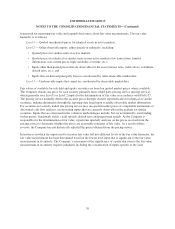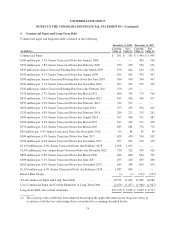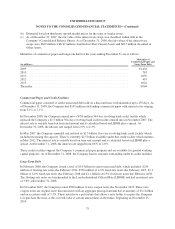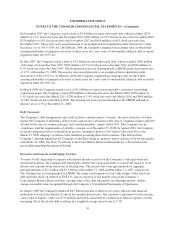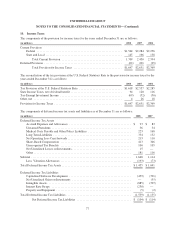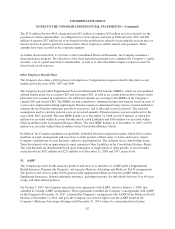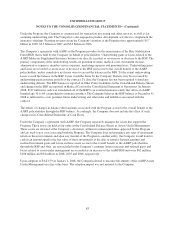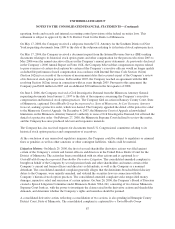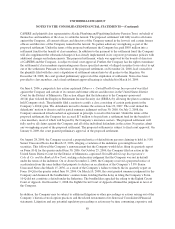United Healthcare 2008 Annual Report Download - page 89
Download and view the complete annual report
Please find page 89 of the 2008 United Healthcare annual report below. You can navigate through the pages in the report by either clicking on the pages listed below, or by using the keyword search tool below to find specific information within the annual report.UNITEDHEALTH GROUP
NOTES TO THE CONSOLIDATED FINANCIAL STATEMENTS—(Continued)
to those established by the National Association of Insurance Commissioners. These standards, among other
things, require these subsidiaries to maintain specified levels of statutory capital, as defined by each state, and
restrict the timing and amount of dividends and other distributions that may be paid to their parent companies.
Generally, the amount of dividend distributions that may be paid by a regulated subsidiary, without prior
approval by state regulatory authorities, is limited based on the entity’s level of statutory net income and
statutory capital and surplus.
In 2008, based on the 2007 statutory net income and statutory capital and surplus levels, the maximum amount of
dividends which could be paid without prior regulatory approval was $3.0 billion. As of December 31, 2008, the
Company’s regulated subsidiaries have paid their parent companies dividends of $4.2 billion, including $1.2
billion of extraordinary dividends approved by state insurance regulators. In 2007, the maximum amount of
dividends which could be paid without prior regulatory approval was $2.5 billion. $2.9 billion was paid to their
parent companies, including $400 million of extraordinary dividends approved by state insurance regulators. At
December 31, 2008, approximately $865 million of the Company’s $21.6 billion of cash and investments was
held by non-regulated subsidiaries and was available for general corporate use, including acquisitions and share
repurchases.
The Company’s regulated subsidiaries had aggregate statutory capital and surplus of approximately $10 billion as
of December 31, 2008, which is significantly more than the aggregate minimum regulatory requirements.
Share Repurchase Program
Under its Board of Directors’ authorization, the Company maintains a share repurchase program (the Repurchase
Program). The objectives of the Repurchase Program are to optimize the Company’s capital structure and cost of
capital thereby improving returns to shareholders, as well as to offset the dilutive impact of share-based awards.
Repurchases may be made from time to time at prevailing prices. During 2008, the Company repurchased
72 million shares at an average price of approximately $37 per share and an aggregate cost of approximately $2.7
billion. At December 31, 2008, the Company had Board of Directors’ authorization to purchase up to an
additional 103 million shares of its common stock.
12. Share-Based Compensation and Other Employee Benefit Plans
The Company’s 2002 Stock Incentive Plan (Plan), as amended and restated May 15, 2002, is intended to attract
and retain employees and non-employee directors, offer them incentives to put forth maximum efforts for the
success of the Company’s business and afford them an opportunity to acquire a proprietary interest in the
Company. The Plan allows the Company to grant stock options, stock appreciation rights, restricted stock,
restricted stock units, performance awards or other stock-based awards to eligible employees and non-employee
directors. The Plan incorporates the following prior plans: 1991 Stock and Incentive Plan, 1998 Broad-Based
Stock Incentive Plan and Non-employee Director Stock Option Plan. All outstanding stock options, restricted
stock and other awards issued under the prior plans shall remain subject to the terms and conditions of these
plans under which they were issued.
As of December 31, 2008, the Company had approximately 58.7 million shares available for future grants of
share-based awards under its share-based compensation plan, including, but not limited to, incentive or
non-qualified stock options, stock-settled stock appreciation rights (SARs), and up to 20.8 million of awards in
restricted stock and restricted stock units (collectively, restricted shares). The Company’s existing share-based
awards consist mainly of non-qualified stock options, SARs and restricted shares.
79



